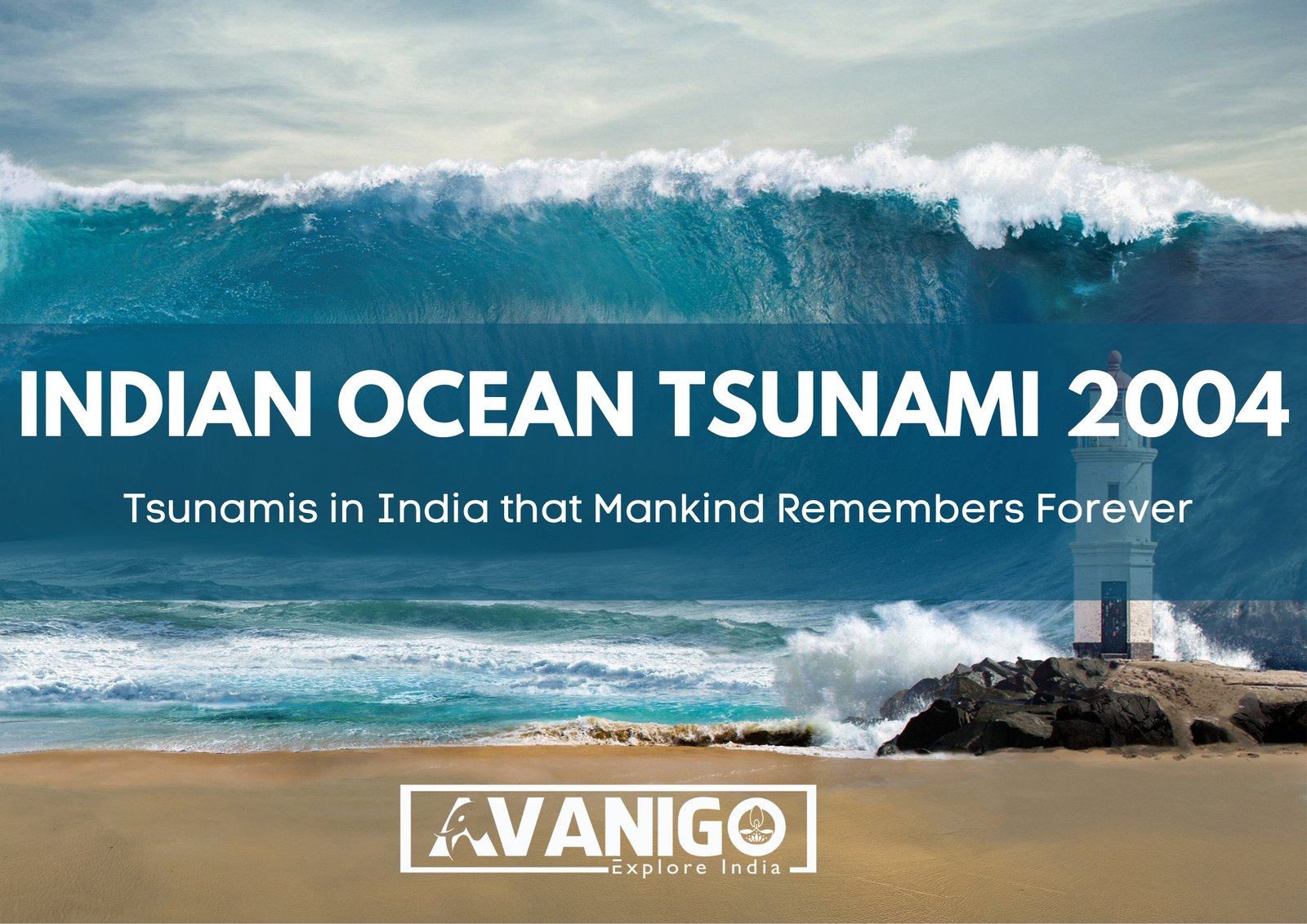It’s on December 26, 2004, nature’s wrath hit the beautiful coast of Southern India severely. That year, a big earthquake underwater took place in the Indian Ocean and gave birth to a massive tsunami. For the next hours and days, enormous waves would break over more than ten countries surrounding the Indian Ocean, wiping vast portions of them out. It is many years later, but the thoughts about that Indian Ocean Tsunami 2004 are still fresh in a lot of people’s minds. Let us go ahead and learn more about this catastrophic Indian ocean tsunami, as well as the list of tsunamis that hit India.
Quick Navigation
What is a Tsunami?
A tsunami represents an extremely massive ocean wave, usually from an underwater earthquake. Along with volcanic explosions or volcanic activities that cause massive water displacement, they form very fast-moving enormous waves, sometimes up to 100m high. In the open sea, however, their size is not so big that one could notice them since they are only a few feet high; when these waves approach within a distance from the shore, they transform themselves into towering giants, resulting in great devastation.
The word ‘tsunami’ is Japanese and means “harbor wave,” reflecting the wave’s appearance and effect in ports or near coasts. It indicates what seismograph recorder shows when the sea floor suddenly drops during an earthquake, displacing overlying water; it’s like an incoming tide at harbors or bays.

The Big Quake of 2004
On December 26, 2004, a colossal earthquake measuring magnitude 9.1–9.3 took place beneath the Indian Ocean near the western part of Sumatra Island in Indonesia. This is one of the most significant earthquakes ever recorded, where two plates met at shallow depths below the ocean’s surface, resulting in its occurrence. By up to 20 meters, the quake caused some portions of the seabed to rise abruptly or descend while displacing vast volumes of water.
This triggered Indian ocean tsunami 2004 waves started radiating outwards in all directions from the quake zone within minutes of the earthquake. The waves traveled at over 800 km/hour in the open ocean but grew in height immeasurably as they started nearing land. Coastal towns and villages in Indonesia, Thailand, Sri Lanka, India, Malaysia, and even some African countries had no idea that a silent killer was racing towards their shores at plane speeds.
By the following day, waves as tall as 17 stories high had smashed into the coasts. Areas within a kilometer of the beach were utterly devastated. The tsunami waves showed no mercy. They overflowed seaside communities, carrying away everything in their path – from automobiles and buildings to trees and people. After the occurrence of the Indian Ocean Tsunami, countless people found themselves homeless, with their lives never the same. The affected locations included Indonesia. Northern Sumatra province of Aceh and the southern coast of Sri Lanka were harder hit than other areas. Only Aceh province lost over one hundred and thirty thousand persons.
Pictures from the region showed a trail of utter destruction, with belongings and debris strewn for miles inland. Rescue operations struggled against time, insufficient equipment, and floodwaters that were begetting diseases. Survivors suffered due to the loss of cherished ones and homes. In retrospect, this area’s enduringly sad remembrance of the mighty tsunami’s horrendous aftermath describes something of a fateful event.
India’s Brush with Tsunamis
Many tsunamis other than the 2004 Indian Ocean tsunami have occurred along the long coastline of India in the past. Some of them were very destructive, although the majority were not noticeable:
- 1926 Sumatra Earthquake Tsunami: An earthquake of 7.6 that occurred northwest of Sumatra led to a tsunami, resulting in more than 500 fatalities in southern India, specifically Chennai. British officials conducted a study that helped advance tsunami science.
- 1877 Great Indian Ocean Tsunami: This catastrophic wave is thought to have originated from an earthquake in the Sunda Trench near Java that killed over 12000 people across the Indian subcontinent, more than 8000 of them perishing in coastal Andhra Pradesh villages.
- 1893 Maharashtra Earthquake: A tremor near Latur led to minor surges of water, which resulted in the death of more than one hundred people along the Coastline of Maharashtra in Konkan District. It was one of India’s first recorded instances of a local tsunami.
- 1964 Alaska Quake Tsunami: Even though across the ocean, waves from this massive 9.2 quake were recorded in the Andamans as high as 1.5 meters, highlighting growing global interconnections.
- 2007 Bengal Tsunami: A weak tsunami observed after a quake off the Northeast Andaman Islands again highlighted India’s vulnerability despite little damage being caused. The Tsunami that destroyed Pamban Bridge in Rameshwaram is also an important one in the history of tsunamis that impacted India.
The looming threat of tsunamis was driven home in 2004. In the aftermath, India established tsunami warning centers and invested in community awareness and infrastructure projects. Special sensors were deployed across the coasts toto quickly detect large quakes or waves and trigger evacuation alerts.
While we can only partially prepare, such timely measures help save precious lives whenever disaster strikes. The immense suffering of the past also reminds us to be sensitive, support each other in times of need, and “Build Back Better.”
Learning Lessons
The Indian Ocean Tsunami 2004 underlined how unaware we were of this natural hazard. Many countries need warning systems, preparedness plans, and public awareness. Satellite and seismic monitoring technology since the 60s could have enabled prompt warnings, but lack of coordination delayed responses. Costly lessons were learned:
- The need for regional early warning systems like the Indian Ocean Tsunami Warning and Mitigation System established in 2005 by UN nations rimming the Indian Ocean. It coordinates seismic and sea-level stations, which can detect tsunamis within 25 minutes and issue advisories.
- India’s 24/7 Tsunami Early Warning Centres at the Indian National Centre for Ocean Information Services in Hyderabad monitor 130 ocean buoys and seismic sensors across the coasts. A national tsunami warning system delivers alerts on televisions and radios instantly.
- State-level disaster management authorities and district-level disaster management plans help coordinate evacuations and relief operations. Regular practice drills and community awareness campaigns make preparation an ongoing process.
- Many villages have devised preparedness plans tailored to their needs – stocking rescue boats, first-aid kits identifying evacuation routes, and relief centers. Flash warnings using mosques, temples, and loud hailers spread alerts faster.
- Coastal regulation rules and land-use policies also protect coastal zones from haphazard construction. Some nations have passed laws declaring certain areas as no-development zones.
- Sea-level gauges have vastly improved predictive modeling capabilities. Bottom pressure gauges study areas vulnerable to submarine landslides, and improved seafloor mapping aids hazard assessments.
- Following the 2004 tsunami that caused widespread devastation, ‘Build Back Better’ highlighted the importance of reconstructing resilient communities to disasters and promoting safer construction methods.
Planning a Safe Future
While we may never be able to stop destructive tsunamis, being aware, prepared, and working as a community can help minimize the risks. As the lessons of Indian Ocean Tsunami 2004 showed us, coming together in times of crisis with compassion for each other strengthens us. The terrors of past tsunamis also remind us that in the more significant game of nature, we all stand equal regardless of who we are. They underscore our shared humanity and our responsibility to build a more caring world that leaves no one behind in times of need.
Swetha is a Content Specialist, LinkedIn Branding and B2B Marketing Consultant. When she is not in the world of B2B, she researches the roots and beauty of Indian Culture and Traditions. She is the author of the book: 365 Days 365 Posts – The Guide to LinkedIn Personal Branding, available exclusively on Amazon. Connect with her on LinkedIn.

